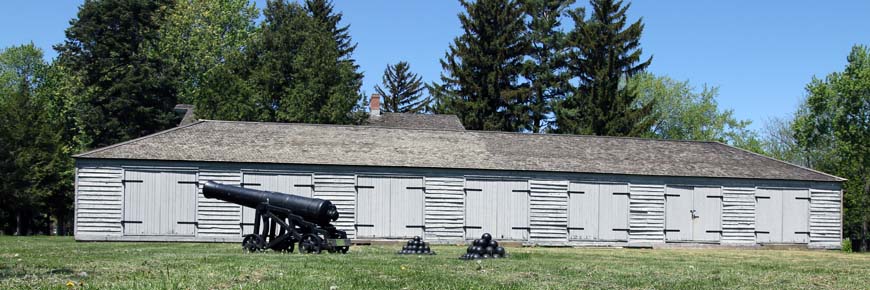
Butler's Barracks National Historic Site
Fort George National Historic Site
History
Butler’s Barracks is a historic military complex located southwest of Fort George National Historic Site in Niagara-on-the-Lake. The site’s designation is related to its military history and British occupation between 1812 and 1871. The historic designation includes the archeological resources and remaining wooden buildings, as well as the landscape features related to the military use of the site, including the Commons (the named coined for the land area on which the complex sits) and the Paradise Grove wooded area.Moving inland and out of range of American guns, this military complex was built to replace what was destroyed during the War of 1812. By 1854, there were 20 buildings situated on the site, which was referred to as Butler’s Barracks. It was named after Colonel John Butler and the Butler’s Rangers, an irregular Loyalist military unit he led during the American Revolutionary War. The surviving structures of this 19th century complex that can be seen today are the Commissariat Stories, the Junior Commissariat Officers’ Quarters, the Men’s Barracks, and the Gun Shed.
One of the buildings that existed on site was the Indian Council House, which played an important role in the consultations between the British Indian Department and their Indigenous allies. It later became a hospital and the area where it once stood is marked with an interpretation panel and benches.
The Commons was passed from the Crown to the Canadian Army in 1871. The area became known as Camp Niagara and was the training grounds and home to the 2nd Division of the Canadian Expeditionary Force. In 1914, the facilities were used to house and train Canadian servicemen headed for the trenches in France. From October 1917 to March 1919, the Polish Army trained at Niagara Camp in an area known as Camp Kosciusko. These men would go on to fight alongside the French Forces in Haller’s Army (also known as the Blue Army). The property continued to be used as an important training ground for Canadian forces up until the 1960s including training troops for the Second World War and the Korean Conflict. A building still remains today from this mid 20th century training base.
Butler’s Barracks is now managed by Parks Canada as part of the Niagara National Historic Sites situated in the Niagara Region.
Site protection and conservation work
Parks Canada is completing a series of infrastructure projects to protect and preserve this historic site, while supporting local economies and contributing to growth in the tourism sector. The Agency is committed to ensuring the approaches used in these conservation projects at our national historic sites conserve our built heritage for years to come. Large-scale work of this nature requires skilled training and any work taking place on a national historic site follows strict standards to preserve the historic value of the site.In 2018, Parks Canada completed structural repairs, exterior rehabilitation work, and a refurbishment of the interior of the Men’s Barracks to create administration offices and meeting spaces, allowing for active use of the building. It now operates as a Parks Canada Field Unit office for Southwestern Ontario. This restoration work received the 2019 Peter J. Stokes award from the town of Niagara-on-the-Lake. Structural work and exterior envelope repairs were also completed for the Commissariat Stores and the Junior Commissariat Officer’s Quarters.
In 2019, remediation work on the Junior Commissariat Officer’s Quarters was completed and work will continue in 2021 to stabilize the interior and exterior of the building.
Visiting this site
This national historic site located off Queen’s Parade in Niagara-on-the-Lake is accessible year-round. Visitors are welcome to visit the Commons, experience of viewscapes of Niagara’s early military history, stroll through the forests in Paradise Grove, and view the exterior of the remaining wooden structures on the site. There are many interpretation panels and installations to see – visit our heritage trails page for trail maps and more information.Free admission
- Date modified :